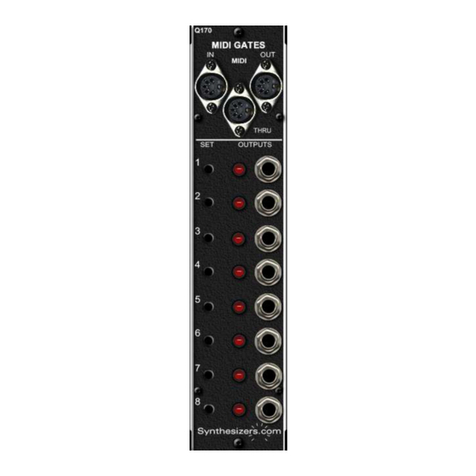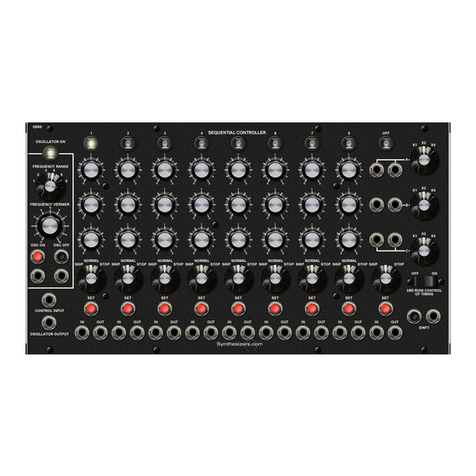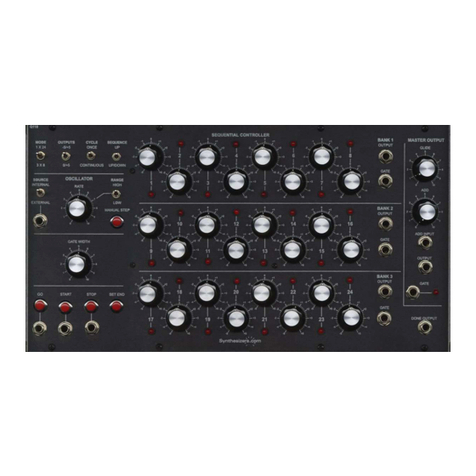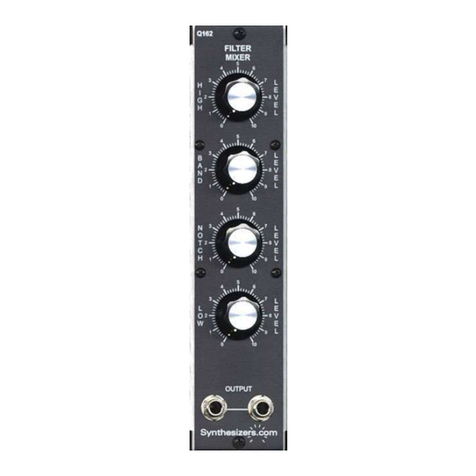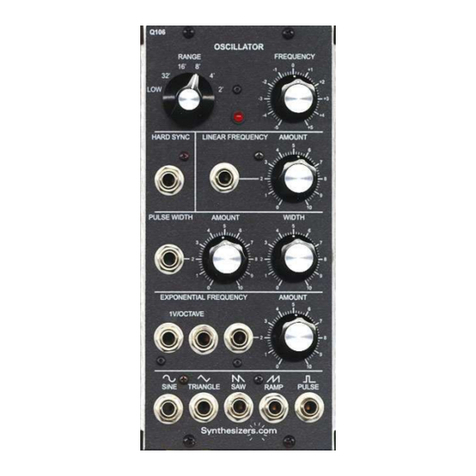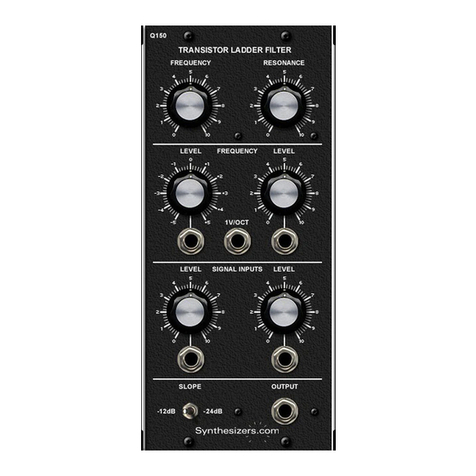
Q109 Envelope Generator
Aug 2014
Usage and Patch Tips
Basics
The envelope generator is usually triggered from the keyboard gate signal and creates a voltage that
changes over time (envelope). Envelope signals are used to change sound parameters over time - usu-
ally filters, amplifiers, and oscillators but really any voltage controllable parameter can be controlled.
Study the waveform pictures to understand what each control does to affect the envelope's shape. When
a gate signal goes high (key is pressed), the Attack phase begins. The time it takes for this attack phase
to complete is determined by the Attack control. The voltage will rise slowly until it reaches +5 volts. At
that time the Decay phase begins and its time it determined by the Decay control. The voltage will decay
to the voltage set by the Sustain level control and will stay there as long as the gate signal is high (key
pressed). When the gate signal goes low the release phase begins and its time is set by the Release con-
trol. If you turn the sustain level full clockwise, there will be no decay phase.
Routing
Since you often need a separate envelope generator for filters and amplifiers, use a Q124 Multiple to
route a single gate signal from the keyboard to several envelope generators.
Inverted, Amplified, Attenuated Envelopes
Some module's inputs have inverters and attenuators that allow you to modify the envelope's affect on the
parameter, but some do not due to space constraints. Use a Q125 Signal Processor to invert, amplify,
attenuate, or offset an envelope signal.
Voltage Levels
The output of the envelope generator is 0 to 5 volts. The Q108 Amplifier responds well to this voltage
range (0 volts = off, +5 volts = full on) so you can patch the envelope directly into the control input of the
amplifier. If you need the envelope to span a larger range such as -5 to +5 volts, simply use a Q125
Signal Processor to amplify the signal by 200% then offset it by -5 volts. This expanded envelope voltage
range can be useful when you want to sweep the Q107 Filter its entire range.
Gates and Triggers
A gate signal stays on as long as a key is pressed, but a trigger signal is a very short pulse that only oc-
curs at the beginning of a keypress. The envelope generator can be started by a gate or a trigger with
different results. When using a gate signal to start the envelope generator, all controls act upon the wave-
form as you would expect, but when using a trigger signal to start it you'll loose the attack and decay con-
trol (Set them to 0). The Sustain and Release controls will work as expected. The result will be the same
regardless of how long you hold down a key.
Starting Envelopes from other Sources
Envelopes are usually started from keyboard gate signals, but you can use an oscillator or a sequencer to
start them too. When using an oscillator to continuously start an envelope generator, you essentially are
creating an oscillator with a customized waveform. Any of the gate signal outputs or the Done output on
the Q119 Sequential Controller can be used to start an envelope generator too. You can start an enve-
lope at a certain stage of a sequence by using a bank's (in 3x8 mode) output signal. Set all of the controls
for the bank to 0 except the stage that you wish to fire which should be set to +5.
Delaying Envelope Triggering
You can delay the triggering of the Q109 using the Q105 slew limiter. Simply run your gate signal
through the Q105. Setting the direction to Up will let the Amount control adjust the delay of the beginning
of the output gate. Setting the direction to Down will let the Amount control adjust the extension of the
output gate. Setting the direction to Both will let the Amount control adjust both the beginning delay and
the
extension resulting in a shifting of the entire gate signal.
Combining Delayed Envelopes to Create Complex Patterns
Using 2 Q109's, trigger one from an unmodified gate signal (possibly from a keyboard or sequencer),
and also patch the gate into a Q105 to create a delay for the second Q109. Combine the outputs of the 2
